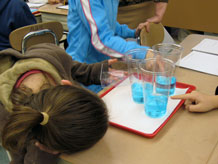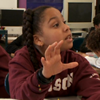How can we compare the volumes of liquids?
4. Make meaning
Purpose of the discussion
The purpose of the discussion is to review the investigation and consolidate students' understanding of key ideas. Focus the discussion on the investigation question.
Engage students in the focus questions
Write the four focus questions on the board:
- How did you compare the volumes of liquids?
- What did you do? (What strategy did you use?)
- Why did you do it?
- What did you find out?
The session began with a challenge: to compare the volumes of three samples of water that were in containers of different shapes and sizes.
In this discussion we'll review what the different groups did, why they did it, and what they found out. Refer to the discussion question and open the discussion.

As students describe the steps in their procedures and why they took them, encourage others to:
- listen carefully (as always!)
- ask for clarification or ask questions when something isn't clear.
- think about how this procedure is the same or different from the one they used
Summarize the discussion
Summarizing this consolidation discussion will also serve as a re-cap of the investigation.
- Our challenge was to find a reliable way to compare the volume of water in three different containers.
- We used different strategies to answer the investigation question. (Review strategies that students presented.)
- No matter which strategy we used, we found that the volumes of water in the three containers were equal.
- We know from the predictions we made that it can be really difficult to compare the volumes of liquids if the containers are not the same size and shape.
Students may complete the optional assessment in their notebooks [What is the volume?].
Conservation of volume and the literal-mindedness of children.
The volume of a liquid is conserved — i.e., it remains the same — no matter what container you pour it into. As you present this fundamental law of nature, some students may become distracted by the possibility of irregularities in the procedure. They may object, for example, that the volume cannot remain the same because tiny drops will cling to the container being emptied. This is true and it’s good that students realize it, but it is beside the point. Acknowledge the truth of objections of this kind, then make your case theoretical by asking:”If we pour every little bit of the water into a different container, will the volume remain the same?“
Literal-mindedness is common in children this age. You can help them move past tiny distractions by pointing out that, we can imagine moving every last bit of water from one container into another.





